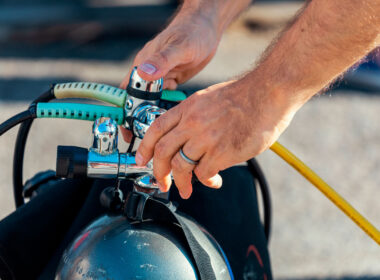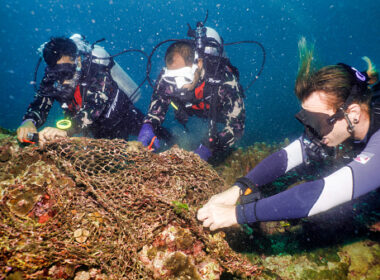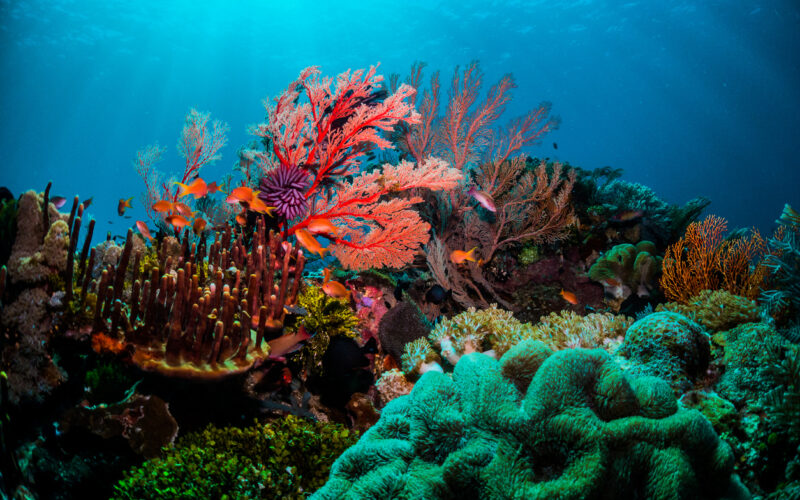Diving in Raja Ampat is an experience like no other. This Indonesian archipelago is located off the northwest tip of Papua, and it boasts the richest marine biodiversity in the world. The warm, clear waters are home to over 1,500 species of fish, 600 species of coral, and countless other marine creatures.
Traveling abroad? Get our special trip coverage for divers – We’ve Got You Covered
One of the best ways to explore this underwater paradise is by going diving. There are many dive operators in the area, and they offer a range of packages to suit all levels of experience.
Popular Dive Locations
One of the most popular dive locations in Raja Ampat is the Misool Island group. This area is home to some of the most vibrant and diverse coral reefs in the world, as well as a wide range of fish and other marine creatures. Diving here is a truly immersive experience, with schools of fish swirling around you and colorful coral formations stretching out in every direction.
Another popular dive site is the Fam Islands. This area is known for its stunning walls and drop-offs, which are home to a diverse range of marine life, including reef sharks, manta rays, and sea turtles. The waters here are crystal clear, allowing you to see for miles in every direction.
If you’re looking for a more challenging dive, the Blue Magic site is a must-visit. This site is famous for its strong currents, which attract large schools of fish and other marine creatures. Diving here requires a bit more experience, but the rewards are well worth the effort.
One of the things that makes diving in Raja Ampat so special is the sheer diversity of marine life that you can see. From tiny nudibranchs to massive manta rays, there is always something new and exciting to discover. And with so many different dive sites to choose from, you could spend weeks exploring this incredible underwater world.
If you’re planning a trip to Raja Ampat, be sure to include some diving in your itinerary. Whether you’re a seasoned pro or a complete beginner, this is an experience that you won’t soon forget. With its warm waters, stunning coral reefs, and incredible marine life, Raja Ampat is truly a diver’s paradise.
Marine Life in Raja Ampat
Raja Ampat is home to one of the most diverse and rich marine ecosystems in the world. The warm, clear waters of this Indonesian archipelago are teeming with a wide variety of marine life, from colorful coral reefs to massive pelagic creatures.
Biodiversity
One of the most notable features of Raja Ampat’s marine life is its incredible biodiversity. The area is home to over 1,500 species of fish, including numerous species that are endemic to the region. This means that you won’t find these fish anywhere else in the world.
In addition to fish, Raja Ampat is also home to a wide variety of other marine creatures, including sea turtles, reef sharks, and rays. You may also spot octopus, cuttlefish, and other cephalopods, as well as crustaceans like crabs and lobsters.
Coral Reefs
The coral reefs in Raja Ampat are a major highlight for divers and snorkelers. The area is home to over 600 species of hard and soft corals, making it one of the most diverse coral reef systems in the world. The reefs are home to a wide variety of colorful reef fish, as well as larger creatures like groupers and barracudas.
Pelagic sightings
For those who enjoy diving with larger creatures, Raja Ampat is also home to several species of pelagic animals, including manta rays, whale sharks, and even occasional sightings of dolphins and pilot whales. These creatures can be found at several dive sites around the archipelago, and diving with them is truly an unforgettable experience.
Overall, Raja Ampat is a marine paradise that offers divers and snorkelers the chance to see an incredible variety of marine life in a stunningly beautiful environment. Whether you’re an experienced diver or a beginner, there’s something here for everyone to enjoy.
Dolphin and Whale Watching in Raja Ampat
Dolphins and whales are among the intriguing marine life that can be encountered in the waters around Raja Ampat. Over 15 different species of whale and dolphin can be sighted in these waters. Amongst these species are the Indo-Pacific bottlenose dolphin, pilot whales, pygmy orcas, brydes whales and sperm whales. These deep-sea mammals are known for their unique features and captivating behaviors.
Raja Ampat offers several great locations for spotting dolphins and whales, and one notable area is around the island of Misool. Misool’s deep-water canyons and steep underwater cliffs provide an ideal habitat for these marine giants. The surrounding waters also teem with a diverse array of marine life, from reef sharks and manta rays to schools of vibrant reef fish.
Encountering a pod of dolphins or whales while exploring the underwater world in Raja Ampat can be a breathtaking experience. These creatures are celebrated for their intelligence and social interactions, often seen swimming in close formation or even engaging with curious divers.
It is essential to approach these majestic animals with respect and caution, as they are wild and should not be disturbed. Divers must maintain a safe distance and avoid any attempts to touch or interact with them, as such actions can lead to stress or harm.
For those interested in whale and dolphin watching tours in Raja Ampat, numerous tour operators offer guided excursions to increase the chances of encountering these incredible marine creatures. These tours typically provide expert guidance, insights into the marine environment, and a heightened opportunity to witness dolphins and whales in their natural splendor.
5 Words to Know in Bahasa
The official language spoken in Raja Ampat is Bahasa Indonesia. More traditional languages and local dialects can be found in the different villages, especially amongst the older generations. With these five words, you can at least show that you are making an effort, something that all Indonesian people will appreciate:
- Selamat pagi – Good morning
- Terima kasih – Thank you
- Pantai – Beach
- Satu – One
- Makanan – Food
Alternatively, why not download a language app before your trip and get to grips on the basic language before arriving in Indonesia.
Liveaboard or Diving Center?
Are you planning to visit Raja Ampat but are unsure about the pros and cons of diving from a dive center or staying on a diving liveaboard. Choosing whether to dive from a land-based dive center or a liveaboard in Raja Ampat, Indonesia, involves several factors, let us sum it up for you and help make your decision easier:
Land-Based Diving:
Pros
Comfort and amenities: Land-based dive resorts typically offer more comfortable accommodations with a variety of amenities, such as air-conditioned rooms, restaurants, and lounging areas.
Diverse activities: In addition to diving, you can explore the local culture, visit nearby islands, and enjoy land-based excursions.
Flexibility: You can choose from a variety of dive sites each day and have more flexibility in planning your schedule.
Community: You’ll have the opportunity to meet and socialize with other divers and travelers at the resort.
Cons
Travel time to dive sites: Raja Ampat is an archipelago, so you may spend more time traveling to dive sites from the resort, which can limit your daily diving options.
Limited dive sites: You might visit the same dive sites more frequently, reducing the diversity of sites you explore.
Liveaboard:
Pros
Maximized dive time: Liveaboards often offer multiple dives per day and allow you to access remote dive sites without lengthy boat rides.
Variety of dive sites: You’ll have the opportunity to explore a wider range of dive sites across different areas of Raja Ampat.
Uninterrupted diving: Enjoy uninterrupted diving with a sleep, eat, dive, repeat philosophy. Join a back to back liveaboard trip to enjoy two or even three weeks of non-stop diving.
Diverse sightings: Liveaboards can take you to different regions with varied underwater landscapes and marine life.
Cons
Limited amenities: Liveaboard accommodations are generally more compact, with fewer amenities compared to land-based resorts.
Space limitations: Living in close quarters with fellow divers may not suit everyone’s comfort and privacy preferences, there is also not much storage space for storing personal items in your cabin.
Sea conditions: Liveaboards are subject to sea conditions, which can impact the comfort of your trip. If diving from land, you could cancel the dive and do an alternative land-based activity, from a liveaboard you are still at sea so the alternatives are limited.
Diving Possibilities and Sightings:
Both land-based and liveaboard diving in Raja Ampat offer incredible opportunities to witness marine life. Some of the diving possibilities and notable sightings include:
Coral Reefs: Raja Ampat is famous for its pristine coral reefs with an abundance of hard and soft corals.
Fish Life: Expect to see a wide variety of fish species, including schools of barracuda, trevally, parrotfish, and numerous species of reef fish.
Manta Rays: Manta rays are a common sight in Raja Ampat, and cleaning stations provide great opportunities for close encounters.
Sharks: Various shark species, including reef sharks and wobbegongs, can be spotted.
Macro Life: Raja Ampat is a haven for macro enthusiasts, with an abundance of critters like pygmy seahorses, nudibranchs, and unique crustaceans.
In conclusion, your choice between a land-based dive center and a liveaboard in Raja Ampat depends on your preferences for comfort, flexibility, and diving experiences. Land-based resorts offer more amenities and a broader range of activities, while liveaboards provide maximum dive time, access to remote sites, and diverse underwater encounters. To make an informed decision, consider your diving goals, travel style, and budget, and remember that both options offer incredible diving experiences in this breathtaking marine paradise.
Whichever you decide upon, you will need a comprehensive coverage to have your back in the event something goes wrong. Get covered – Get DiveAssure.
Safety Tips for Visiting Raja Ampat
Raja Ampat is a relatively safe place to visit, but as with any travel destination, it’s important to take certain precautions to ensure your safety. Here are some safety tips to keep in mind while visiting Raja Ampat:
- Be aware of your surroundings: As with any unfamiliar place, it’s important to be aware of your surroundings and keep an eye out for any potential dangers. Stay in well-lit areas at night, and avoid walking alone in secluded areas.
- Protect yourself from the sun: Raja Ampat is located close to the equator, which means that the sun can be extremely strong. Be sure to wear sunscreen and protective clothing to avoid sunburn and heatstroke.
- Use mosquito repellent: Mosquitoes and other biting insects can be common in Raja Ampat, particularly during the rainy season. Use mosquito repellent to avoid getting bitten, and consider wearing long-sleeved clothing to provide additional protection.
- Follow the instructions of your dive operator: When scuba diving or freediving, be sure to follow the instructions of your dive operator at all times. It is important to know the particular dangers, weather conditions, emergency procedures, max depths and max dive times for each dive. This will help to ensure that you have a safe and enjoyable diving experience.
- Respect the local culture: Raja Ampat is home to a number of different indigenous communities, and it’s important to respect their culture and traditions. Dress modestly and be mindful of local customs and practices.
- Get Covered: We strongly advise all travelers and divers to secure comprehensive insurance before embarking on their journey. Given Raja Ampat’s remote location, having premium coverage is especially critical. In the event of an emergency, an evacuation to the nearest hospital can be both time-consuming and expensive, and certain treatments may even necessitate repatriation to your home country. While no one likes to consider such possibilities, being prepared ensures peace of mind. Should the unexpected occur, you’ll be grateful to have the right protection in place.
By following these safety tips, you can help to ensure that your visit to Raja Ampat is a safe and enjoyable one.






